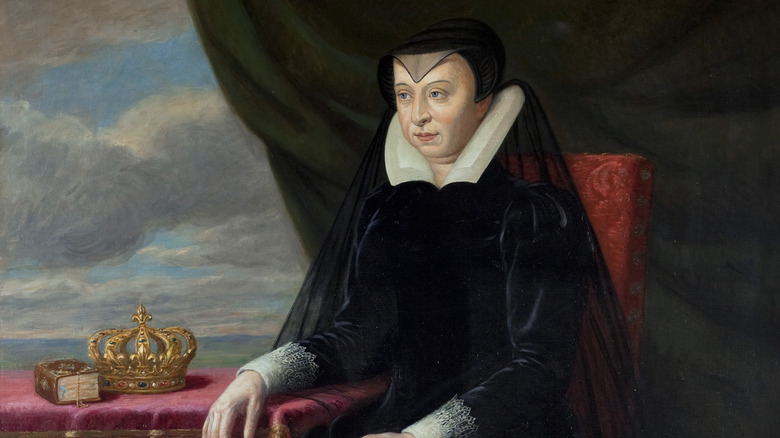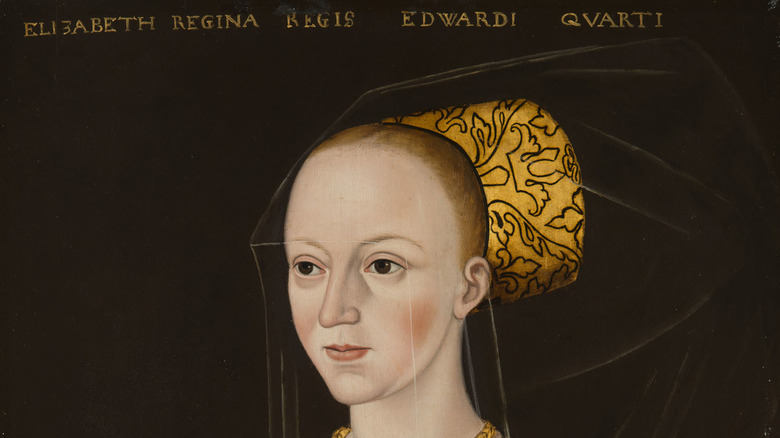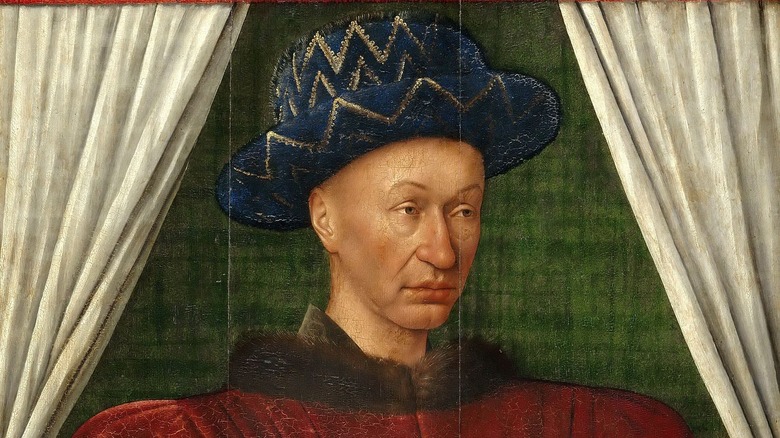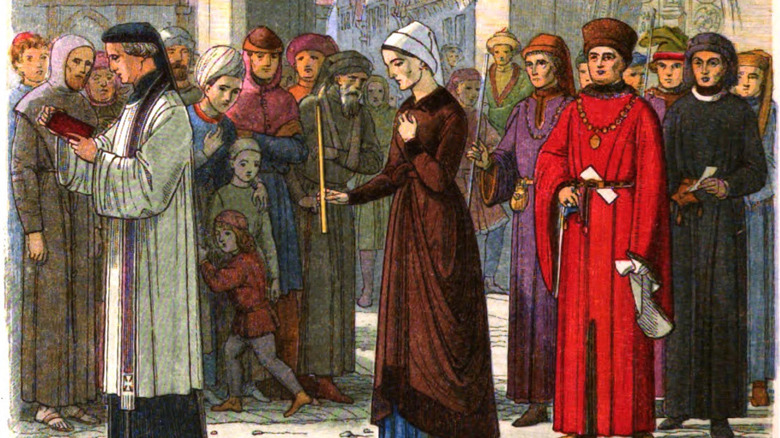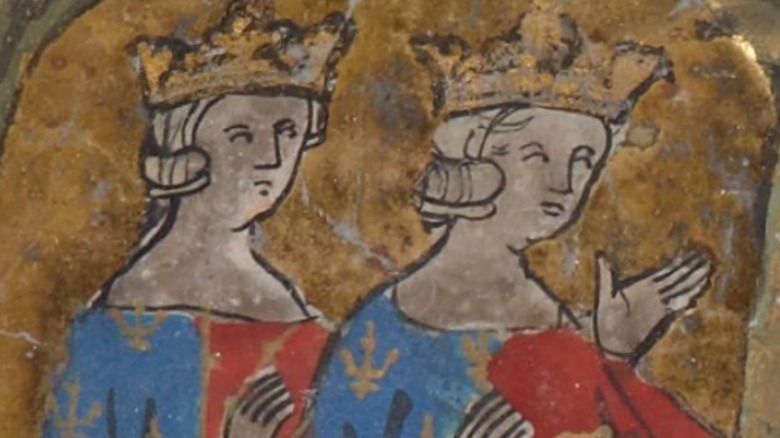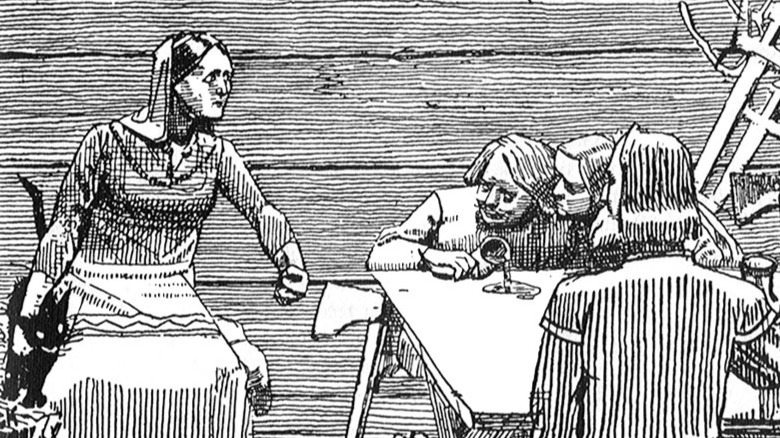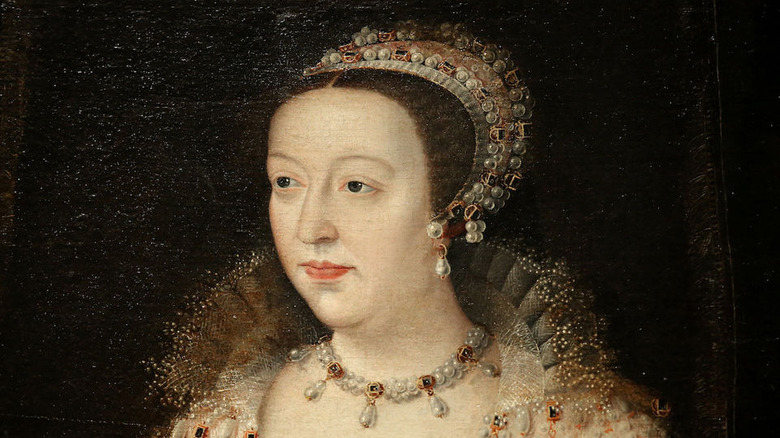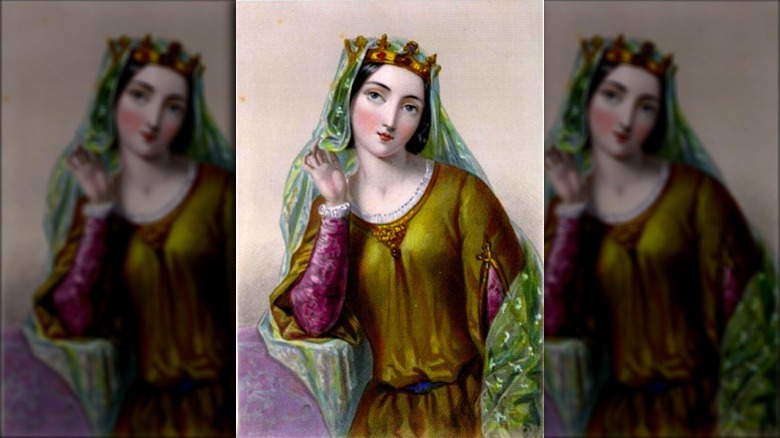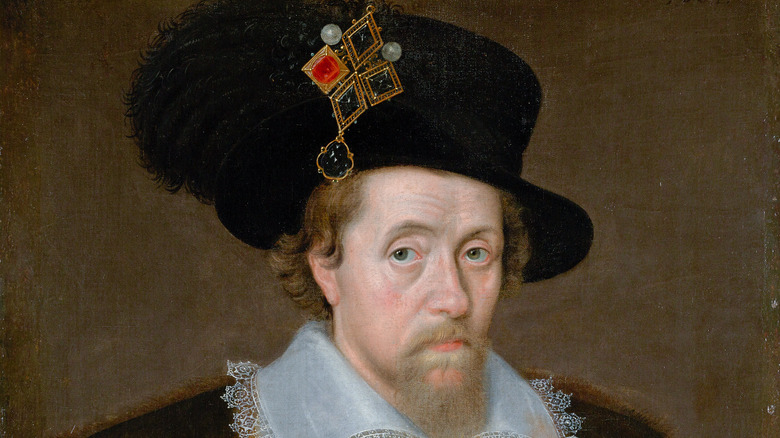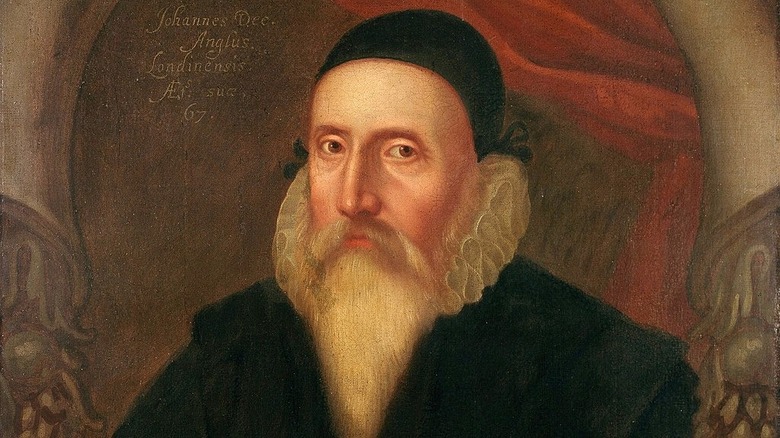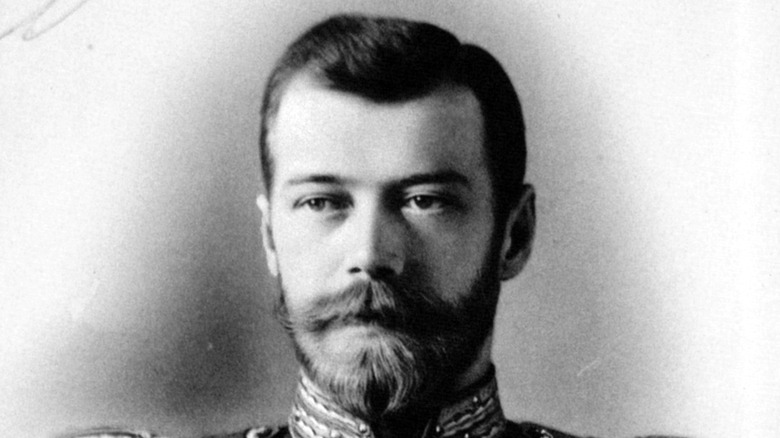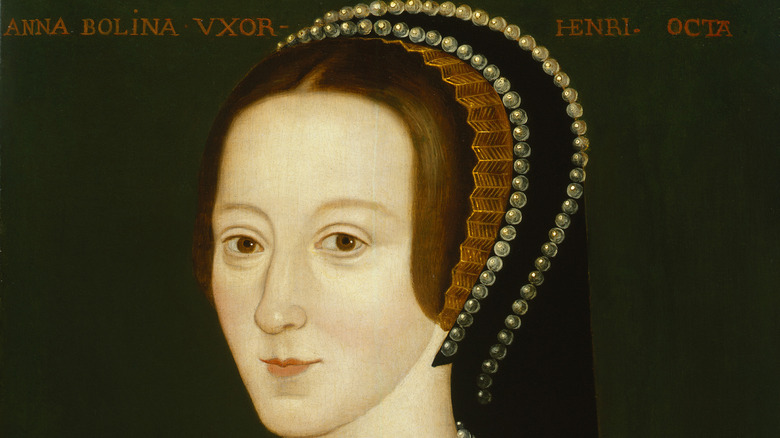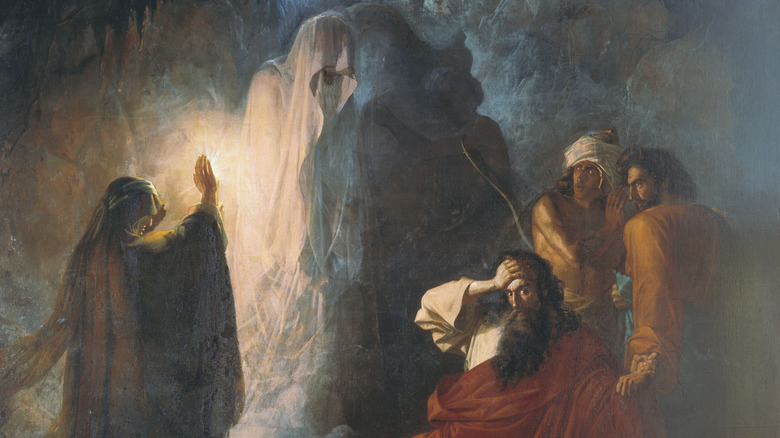Royalty Who Dabbled In Witchcraft
Being a royal certainly has its perks, including fabulous riches, grand estates, and easy access to the best services like top of the line healthcare and really pretty wedding venues. But it can also come with some serious caveats, like nasty tabloids and paparazzi hounding your every move. Yet, even modern royals struggling with such attention might breathe a sigh of relief as they contemplate the fates of their historic predecessors. They may have to live in the public eye, but at least no one's accusing them of witchcraft.
For some historical royals, however, the lure of the occult proved just too intriguing. Even with the threat of damaging gossip, public trials, and the possibility of a deadly witch hunt, some leveraged their power and education to bend the rules. The medieval English queen Elizabeth Woodville was only tangentially connected to witchcraft through gossip and accusations, but others, like the French queen Catherine de' Medici, more obviously toyed with the occult in an attempt to gain and keep power. It seems that all royals who dabbled in witchcraft walked a pretty fine line, and that for many, their interest led to disaster. Meet the royals who dabbled in witchcraft.
Elizabeth Woodville and her mother were accused of being witches
The BBC reports that Elizabeth Woodville was the wife of 15th century King Edward IV. Just a few years into their marriage, disaster struck the royal couple. In 1471, Edward was imprisoned by the Earl of Warwick, who put Henry VI on the throne and who also had Elizabeth's father executed. As if that weren't enough, Warwick accused Elizabeth's mother, Jacquetta, of witchcraft. Months later, Edward was back on the throne and investigating the same claims. His council found them to be false, but it would prove difficult for Jacquetta and her daughter to escape the association even after the king first signed off on their innocence.
Edward died in 1483, leaving his 12-year-old son as Edward V, the boy king's uncle Richard as regent, and Elizabeth as a uniquely vulnerable widow. Young Edward and his brother quickly vanish from the historical record, leaving Richard to step in as Richard III. And, as for Elizabeth? Richard reportedly brought up the old accusations of witchcraft, saying that Elizabeth used her unholy powers to marry Edward IV. She was never brought to trial, though it was undoubtedly traumatic. Elizabeth at least managed to live past Richard's reign and into that of Henry VII, dying in 1492 (via "Henry VII: The Maligned Tudor King").
Charles VII of France was fascinated by the occult
Medieval French king Charles VII was reportedly fascinated by astrology and occult matters, according to History Extra. Being a king, he apparently had the sort of power to avoid persecution for the matter, the education to expose him to the topic and allow him to read about it, and the funds to feed his hobby. It's reported that by the middle of the 14th century, when he was still heir to the throne, Charles had a staggering library devoted to astrology. Later, he even established a college of astrology in Paris.
As the British Library demonstrates, medieval astrology lay in a gray area between science and outright witchcraft. Charles likely felt secure exploring his interest because of his position, but one wonders if a rural French woman with the same interests would have fared quite as well as he did.
Charles VII may have been taking his lead from his father, a "mad" king who was at times reportedly the victim of witches. According to the BBC, Charles VI was widely known to be mentally unstable, to the point where he even occasionally believed that he was made of glass. Some blamed the delusion on the duchess of Orleans, Valentina Visconti, per the journal Parergon. The accusations against Visconti became so fierce that she left Paris, fearing for her safety.
Eleanor Cobham was charged with witchcraft
Eleanor Cobham first comes into play as a lady in waiting for Jacqueline, countess of Hainault, according to Royal Central. Sometime around 1425, Eleanor took up with Jacqueline's husband, Humphrey, duke of Gloucester. Within a few years, Humphrey had gotten an annulment from Jacqueline, married Eleanor, and things were looking pretty good for the young upstart as she and her husband managed a prosperous household.
Then, in 1435, the heir to the throne died, suddenly leaving Humphrey next in line to the throne after his nephew, Henry VI. Humphrey was also lord protector for young Henry. Eleanor reportedly leaned hard on astrology to see what the future held for her and her husband. However, as History of Royal Women reports, that was to be her undoing. Soon enough, reports came in that Eleanor had predicted the young king's death and was perhaps even using witchcraft to hasten it along.
Eleanor was arrested and sentenced to life in prison after a dramatic 1441 public penance in which she solemnly carried a large candle from church to church while all of London watched. It was a far better fate than some of her other alleged conspirators, however, who were executed in dramatic fashion. She remained in prison until her death in 1452.
Joan of Navarre was accused of using witchcraft to snag a king
According to History of Royal Women, Joan was the daughter of King Charles II of Navarre and Joan of France. She was first married to John IV, duke of Brittany, an alliance that linked the young royal with a man three decades her senior. After John's death in 1399, Joan fatefully married the future Henry IV of England. At that point, she was not only very rich but seriously powerful, sitting as the regent of Brittany in France. She gave up that regency upon marrying Henry in 1402 but was still a force to be reckoned with when she traveled to England.
Jezebel reports that Joan was granted even more riches by Henry before he died in 1413. Soon after, the witchcraft accusations started flying. English Heritage reports that, like so many royal women in similar situations, she was supposedly guilty of plotting her husband's death via magical means.
It may have all been a convenient excuse used by her stepson, Henry V, to seize her considerable fortune and property, which he did without much delay. He had Joan imprisoned but, key to her reputation, she was never put on trial for the charges. In 1422, Henry V released Joan and returned her fortune as he was dying. She lived until 1437.
Gunnhild was possibly a real Viking queen who also worked magic
According to patchy historical records and the quasi-fictitious Icelandic sagas, Gunnhild was a Viking queen who gained a considerable reputation for sorcery and curses. History Answers explains that she may be fictional, or at least the details are, given the many years between Gunnhild's time and our own. Still, there's a possibility that Gunnhild existed in some form. And, given the importance of magic to 10th century Scandinavia, there's a chance that whatever queen or female leader inspired Gunnhild had a seriously witchy reputation.
Per the introduction to a 2004 edition of "Egil's Saga," Gunnhild is certainly depicted as a magically powerful figure in the Icelandic tale. She is so "well-versed in the magic arts" that she becomes a kind of recurring villain for Egil Skallagrímsson, the saga's central hero. Gunnhild attempts to mess up Egil's adventures via poison, curses, and soothsaying. She is repaid with a notorious reputation, often fleeing an area when she becomes too feared for her own good.
It's said that Gunnhild ended her days when King Harald Bluetooth of Denmark commanded that she be thrown alive into a bog and drowned for her frightening magic wickedness. It was such a persistent legend that when a real bog body known as the Haraldskær Woman was uncovered in 1835 in Denmark, some believed that she was none other than Gunnhild, Smithsonian reports.
Catherine de' Medici was notoriously fascinated by the occult
Catherine de' Medici, Italian royal, queen of France, and matriarch of a powerful and scandalous Renaissance family, wasn't above some witchcraft. You can hardly blame her, given the cutthroat world of European politics in the 16th century, though it can be said that Catherine sometimes took it all a bit too far.
Longreads reports that Catherine had her own dedicated royal astrologer, a man named Cosimo de Ruggiere. He came to prominence after Catherine's husband, Henry II, died of apparent blood poisoning two weeks after a gruesome jousting accident left splinters in his eye and head. As a new widow and queen mother to the teenage king, Francis, Catherine suddenly found herself in a politically volatile situation. Presumably wanting to seek out some stability, she had Ruggiere hold up a reportedly magic mirror. Gazing into its depths, it's said that she learned that three of her sons would reign as kings, though only for a relatively short time before a cousin took over.
It was also rumored that Catherine was a kind of poison master, secreting vials of deadly substances in her rooms. According to Atlas Obscura, that may have been some rather nasty misinterpretations of Catherine's love of perfume and scented accessories, which morphed into a legend that she murdered a rival with a pair of poisoned gloves.
Isabella of Angouleme reportedly messed up England's royalty with witchcraft
King John has a pretty terrible reputation. He is, in the words of the BBC, often portrayed "the classic villain," a scheming fool who lost most of his power to other players in the political games of 13th century Britain.
If being one of England's least-loved kings wasn't bad enough, try being his wife. Isabella of Angouleme married John when she was about 12 years old, according to Royal Central. Her husband had just secured the throne after the death of his brother, Richard I, and given that his new wife was from a powerful French family, he may have wanted to secure some vital support to control his territories on the continent.
Isabella was said to be remarkably beautiful and compelling, setting off gossip that her husband was so bad at his job because she bewitched him out of being a good king. The slander continued even after John's 1216 death and Isabella's second marriage. In the 1240s, a series of accusations arose that Isabella had conspired to harm France's king, Louis IX, allegedly teaming up with a couple of cooks to poison the monarch.
Though she was never detained or put on trial, it seems that Isabella knew when to bow out before the heat got to be too much. She retreated to an abbey and remained there until her death in 1246.
James I's obsession with witches kicked off a panic
James VI of Scotland and I of England was both fascinated and horrified by witches. He wasn't the only one, according to National Geographic. During the 16th and 17th centuries, it seemed as if all of Europe was in a state of paranoia over witches. Scotland, James' homeland, was especially susceptible to the panic, killing off suspected witches at about five times the rate that accused witches were executed elsewhere in Europe.
James was, in a way, understandably obsessed with the impact that witchcraft and the occult would have on his life, to the point where he seemed helplessly bound to engage with the dark arts himself. In 1591, it was purportedly revealed that witches had even banded together to end his life. Agnes Sampson, an accused witch, confessed that she and hundreds of other magical workers had plotted to kill the king the year before.
Years later, while Queen Elizabeth I was ruling over England, and he was the sovereign of Scotland, James published his book, "Daemonologie." An intellectual survey of the so-called witchcraft problem plaguing the king and his fellow Christians, it served to prove that James, who was downright paranoid about witches at this point, couldn't help but to stare back at the supposed threat in fascinated horror.
Elizabeth I had a dedicated astrologer
Whereas James I was apparently both fascinated and disgusted by the occult, his predecessor on the English throne appeared to be more comfortable with the witchy side of things. Queen Elizabeth I even went so far as to employ a man named John Dee, a mathematician and occultist who often acted as her astrologer and an advisor. According to Britannica, Dee was something of an intellectual powerhouse, becoming a fellow of Trinity College, Cambridge, in 1546, and following that achievement up with a series of scientific vacations to Europe in the following years.
He purposefully hitched his wagon to the royal circle, turning down prestigious offers from the University of Paris and Oxford to aim for a spot by the queen's side. Queen Mary, that is. He was first an astrologer for Elizabeth's elder sister, who preceded her as queen and who nurtured a pretty acrimonious relationship between the two. Elizabeth kept him on when she became queen in 1558.
Besides his many scientific efforts, Dee also attempted to hold seances and speak with angels, though it's not clear how much of these activities he shared with his queen. According to the British Library, he also amassed a pretty significant collection of magical artifacts, including a "spirit mirror," magical figures, and a golden disc. The disc was engraved with a representation of a vision experienced by Edward Kelley, a criminal who also claimed to be able to help Dee with his spiritual pursuits.
Nicholas II brought the occult into Russia's imperial court
When you consider the waning days of Russian royalty and the occult, chances are pretty good that you think of Rasputin. But, as creepy as he may have appeared, Biography maintains that Rasputin presented himself as a devout Christian, albeit one with a mystical bent.
The links between the Romanovs and the occult began well before Rasputin made his debut on the imperial scene. According to the Historian, Tsar Nicholas II and his family were already interested in some very witch-like activities and figures. Indeed, it could be that Nicholas and his wife, Alexandra, steadily turned to the occult as they had trouble producing a healthy male heir.
Soon enough, the court was graced by a variety of personalities. One included a woman known as Mantronuskha the Barefooted, a peasant woman who endlessly rambled on, sometimes dropping in a prediction about a son for the royal couple. Another, Demchinsky, was a meteorologist who Nicholas may have thought was also able to predict the future along with the weather.
Others were of somewhat higher class, though all were said to have uncanny powers connected to an unseen and highly mystical spirit world. Though most of them came to the royal couple with a gloss of Orthodox Christianity, there's no doubt that the eerie, witch-like edge of their doings were deeply compelling for the Romanovs.
Anne Boleyn was accused of witchcraft
Anne Boleyn, the second wife of England's Henry VIII, was briefly accused of using witchcraft against her husband before her 1536 beheading. According to SyFy Wire, Henry claimed that she had bewitched him into marriage, and there were rumors that she had certain telltale traits of an enchantress, such as a sixth finger and suspicious moles. There's no recorded evidence of her having these physical features, but that didn't matter. It was also rumored that her stillborn son was born with physical disabilities, which at the time was often taken as evidence of the mother's evil dealings with Satan.
Though Anne couldn't have been directly condemned for being a witch (that wouldn't happen until an act passed in 1563, under Elizabeth I's watch), the whisperings were certainly deeply damaging. After all, who would want to go against the king to support his witch wife?
King Saul worked with the Witch of Endor
The Biblical King Saul, the first ruler of Israel, apparently knew how to talk a big game but was not quite so committed to the part where he had to follow his own rules. According to Britannica, he shows up in the Old Testament book of 1 Samuel, where he eventually bans all magic workers from his kingdom. But, with a big battle against the Philistines looming on the horizon, Saul decides to walk back the law for his own benefit. You can imagine him muttering "just this once" to himself.
Saul decides that he simply must know the outcome of the battle and, to do so, he needs to speak with some otherworldly spirits. He locates a woman known as the Witch of Endor. After reassuring her that he definitely won't have her killed or banished, the woman calls up the spirit of the dead leader Samuel. In 1 Samuel, the ghost of Samuel is none too happy about being called up and breaks the news that God doesn't support the king anymore, and both Saul and his sons will die in battle the next day.
